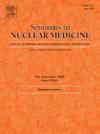New Targets for Positron Emission Tomography Imaging in Parkinson´s Disease
IF 5.9
2区 医学
Q1 RADIOLOGY, NUCLEAR MEDICINE & MEDICAL IMAGING
引用次数: 0
Abstract
In recent years, the neuroimaging biomarkers for Parkinson’s disease (PD) has advanced rapidly, targeting to the key pathological mechanisms such as α-synuclein (α-syn) aggregation, neuroinflammation, mitochondrial dysfunction and brain clearance. This review summarized the novel imaging targets and their clinical practice in human studies. The presynaptic dopamine transporters and 18F-Fluorodeoxyglucose positron emission tomography (PET) have been characterized as established biomarkers in PD. Furthermore, as the key pathogenic protein in PD, α-syn aggregation forming Lewy bodies could drive the neuronal degeneration, making the α-syn-targeted PET imaging a critical focus in PD research. Other co-pathologies, including amyloid-β and tau protein, were also concluded for their clinical implications in PD. Additionally, the PET imaging targets for neuroinflammatory mechanisms, including mitochondrial dysfunction, microglial and astrocyte activation, hold promise for further investigation. Finally, the radiotracers detecting disruptions of blood-brain barrier and glymphatic system would also represent as therapeutic opportunities. In conclusion, the vigorous development of novel imaging biomarkers in PD will refine the diagnostic frameworks, promoting for the future disease-modifying therapies.
帕金森病正电子发射断层成像的新靶点。
近年来,帕金森病(PD)的神经影像学生物标志物研究进展迅速,主要针对α-突触核蛋白(α-syn)聚集、神经炎症、线粒体功能障碍和脑清除等关键病理机制。本文综述了新型成像靶点及其在人体研究中的临床应用。突触前多巴胺转运蛋白和18f -氟脱氧葡萄糖正电子发射断层扫描(PET)已被表征为帕金森病的既定生物标志物。此外,α-syn聚集形成的路易小体是PD的关键致病蛋白,可驱动神经元变性,因此α-syn靶向PET成像成为PD研究的关键焦点。其他共同病理,包括淀粉样蛋白-β和tau蛋白,也总结了它们在PD中的临床意义。此外,PET成像目标的神经炎症机制,包括线粒体功能障碍,小胶质细胞和星形胶质细胞活化,有希望进一步研究。最后,放射性示踪剂检测血脑屏障和淋巴系统的破坏也将代表治疗的机会。总之,PD中新型成像生物标志物的蓬勃发展将完善诊断框架,促进未来的疾病改善治疗。
本文章由计算机程序翻译,如有差异,请以英文原文为准。
求助全文
约1分钟内获得全文
求助全文
来源期刊

Seminars in nuclear medicine
医学-核医学
CiteScore
9.80
自引率
6.10%
发文量
86
审稿时长
14 days
期刊介绍:
Seminars in Nuclear Medicine is the leading review journal in nuclear medicine. Each issue brings you expert reviews and commentary on a single topic as selected by the Editors. The journal contains extensive coverage of the field of nuclear medicine, including PET, SPECT, and other molecular imaging studies, and related imaging studies. Full-color illustrations are used throughout to highlight important findings. Seminars is included in PubMed/Medline, Thomson/ISI, and other major scientific indexes.
 求助内容:
求助内容: 应助结果提醒方式:
应助结果提醒方式:


